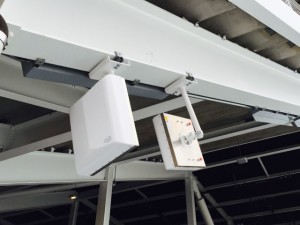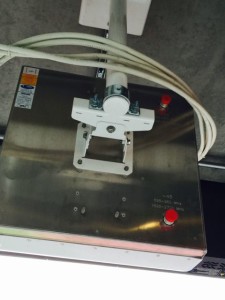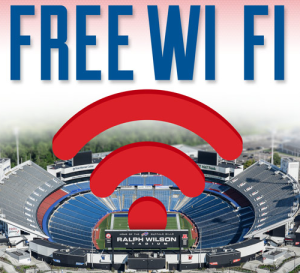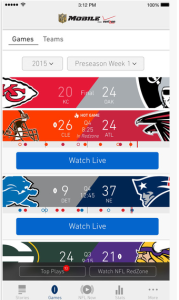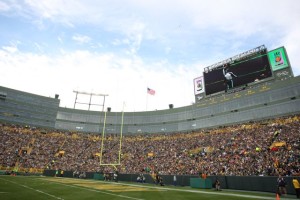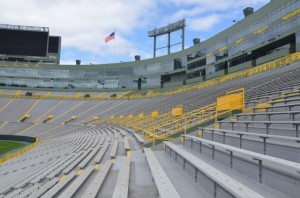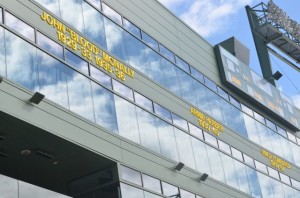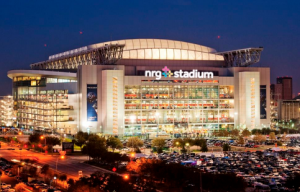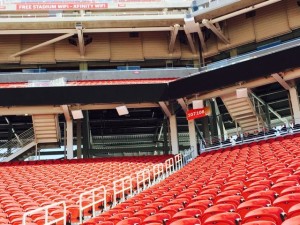
New ‘chiclet’ DAS antennas visible on the concourse overhangs at Levi’s Stadium. All photos: Paul Kapustka, MSR (click on any photo for a larger image)
How about completely re-deploying a new DAS at Levi’s Stadium during the football offseason, just about doubling the capacity in a construction project that took place at a “live” venue instead of one under construction?
The ambitious renovation of the not-quite-1-year-old Levi’s Stadium DAS was all done in the name of Super Bowl 50, the NFL’s big game that is coming to Levi’s Stadium in February 2016. According to DGP president Steve Dutto, the huge jump in wireless traffic statistics at Super Bowl XLIX last February got the major wireless carriers working early to assure that the NFL’s 50th Super Bowl would have enough cellular capacity.
In addition to new antennas from DAS gear supplier JMA Wireless that can be more finely tuned, and more antennas and remote units to beef up coverage and support more cell sectors inside Levi’s Stadium, DGP and stadium owner the San Francisco 49ers also increased the DAS footprint outside the stadium in the adjacent parking lots, addressing what Niners COO Al Guido told MSR was a “primary concern” heard from fans during the inaugural Levi’s Stadium season.
Though work on the DAS will likely continue throughout the season, most of the construction and deployments were expected to be in place for the Niners’ regular season opener tonight versus the Minnesota Vikings.Ready for another ‘Super’ cellular day
Though the unofficial totals for DAS traffic at the last Super Bowl that were in excess of 6 terabytes were the highest we’ve ever seen reported, DGP’s Dutto said that the top wireless carriers are expecting as much as 2.5 times that amount of traffic at Super Bowl 50, a load that might have swamped even the previously robust Levi’s Stadium DAS.
“The [cellular] traffic at the Super Bowl this past year was greater than anything anybody had seen,” Dutto said in a recent interview at Levi’s Stadium. All the carriers, he said, were “amazed” at the traffic jump from the year before, when AT&T and Verizon Wireless reported a combined total of about 2.5 TB of cellular data at Super Bowl XLVIII at MetLife Stadium in New Jersey. (For what it’s worth the Wi-Fi traffic also just about doubled, from 3.3 TB to 6.23 TB.)
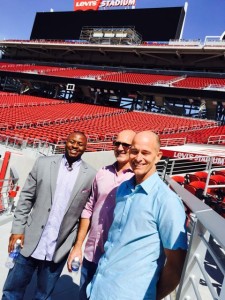
The DGP team at Levi’s for our interview included, L to R, Derek Cotton, director of engineering; Steve Dutto, president; and Vince Gamick, VP and COO.
Under seat DAS antennas part of the upgrade
Inside the stadium itself, Dutto said that Verizon will expand its coverage from 60 to 80 sectors, while AT&T will increase from 45 to 54 or more sectors. DGP will increase its “zones” of coverage in the main seating bowl from 23 to 40, and will go from 250 antennas to 400, and from 330 remote units to 450. There will also be plenty of new antennas from JMA that Dutto said have “greater gain and sharper patterns” to enhance coverage.
“It’s almost like deploying twice the network in the same amount of time,” Dutto said. The other big difference from last year, however, was that Levi’s Stadium was open for events this past football offseason, from WrestleMania 31 to a NHL Stadium Series game to concerts with the Grateful Dead and Taylor Swift.
Though there was more than enough cabling areas and pathways to make the retrofit easier, Dutto said working around the live events increased the deployment degree of difficulty. But even with new head end rooms and extras like under-seat DAS antennas (a new deployment method at Levi’s Stadium for DAS), 20-plus new antenna placements in the parking lot and the accomodation of new 2.5-GHz spectrum for Sprint, Dutto said that the new network was expected to be at least “90 percent complete” before the season’s start.As is regular with lead-ups to Super Bowls, there will likely be even more network tweaking and adjustment up until the last minute before kickoff on Feb. 7, 2016.
A ‘heart-attack” moment and hot dog machines
With any luck, the new network will work as well as the old one, and will hopefully light up without the “heart attack moment” that happened just before opening day last fall. Dutto and his team of Derek Cotton, director of engineering, and Vince Gamick, DGP’s vice president and COO, told of coming to Levi’s Stadium for the regular season opener last September and almost keeling over when they couldn’t detect the DAS network anywhere inside the building.
As it turns out, Dutto said that the major wireless carriers had forgot to turn down the power on their macro towers at the cell sites that surround Levi’s Stadium, which basically overwhelmed the internal network since Dutto said the outdoor cell sites operate at 80 watts, compared to the 2-watt in-stadium DAS network.
“There are six cell sites within hundreds of feet [of Levi’s Stadium] and since they hadn’t turned them down, we couldn’t see the network in the stadium,” said Dutto, whose pulse was revived when the situation was quickly rectified.
At least the Levi’s Stadium DAS couldn’t be turned off by stadium workers or blacked out by hot dog machines, problems that DGP encountered at the Niners’ old home, Candlestick Park, where DGP deployed a test DAS in the 49ers’ final season there in 2013. According to Dutto, for some reason the DGP network was connected by utility PG&E to the same electrical routes as the cookers for stadium hot dogs — and when those were turned on one Sunday the system was overloaded, bringing the DAS down with sausages.The Candlestick DAS also suffered an outage when the park rangers who lived at the stadium thought the equipment air conditioners were too loud, so they turned them off — setting off multiple alarms for Dutto and his network administration team.
Safe to say, similar problems aren’t expected to arise as DGP and the Niners prepare Levi’s Stadium’s cellular network for Super Bowl 50, a tough task but one with rewards on both a personal and business level.
“This has been fun, and the Niners have been great to work with,” said Dutto.
